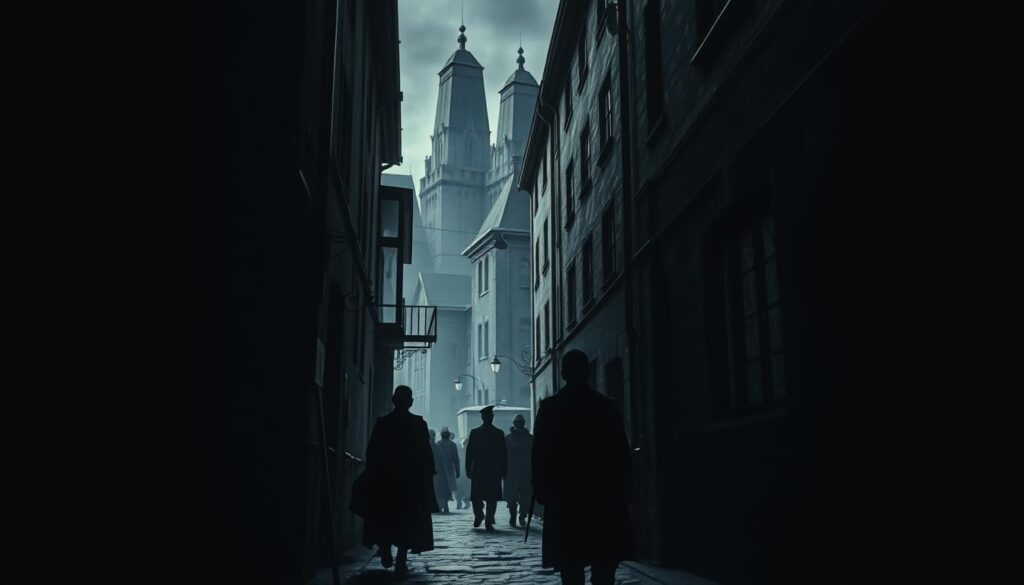
Table of Contents
- 1 Exploring the Dark Era of Hitler’s Dictatorship
- 2 Life in Nazi Germany: A Society Transformed
- 3 The Erosion of Civil Liberties and Human Rights
- 4 Daily Life Under Totalitarian Control
- 5 The Indoctrination of German Youth
- 6 The Role of German Women in Nazi Society
- 7 Life in Nazi Germany: Cultural and Artistic Expression
- 8 The Impact of Total War on German Citizens
- 9 Resistance and Opposition to the Nazi Regime
- 10 The Aftermath: Rebuilding Germany After World War II
- 11 FAQ
- 11.1 What was the rise of the Nazi Party in Germany?
- 11.2 How did the Nazi regime transform German society?
- 11.3 What was the impact of the Gestapo and the culture of fear in Nazi Germany?
- 11.4 How were the German youth indoctrinated under the Nazi regime?
- 11.5 What was the role of German women in Nazi society?
- 11.6 How did the Nazi regime impact cultural and artistic expression in Germany?
- 11.7 What was the impact of total war on German citizens?
- 11.8 How did resistance and opposition to the Nazi regime manifest?
- 11.9 How did Germany rebuild after the collapse of the Nazi regime?
- 11.10 About The Author
Life in Nazi Germany. As the Nazi Party rose to power in the early 1930s, Germany underwent a profound transformation from a democratic system to a totalitarian dictatorship under the rule of Adolf Hitler. This dark chapter of history was marked by the erosion of civil liberties, the persecution of Jews and other minority groups, and the complete control of the state over every aspect of German society. The article delves into the harsh realities faced by the German people during this tumultuous era, shedding light on the impact of Hitler’s ideology and propaganda, the indoctrination of the youth, the role of women, and the resistance that emerged against the oppressive regime.
Key Takeaways
- Explore the rise of the Nazi Party and the establishment of Hitler’s totalitarian dictatorship in Germany.
- Understand the erosion of civil liberties and the systematic persecution of Jews and other minorities under Nazi rule.
- Examine the impact of the Nazi regime on the daily lives of German citizens, including rationing, economic hardships, and the indoctrination of the youth.
- Discover the role of women in Nazi society and the resistance movements that emerged against the oppressive regime.
- Gain insights into the aftermath of World War II and the rebuilding of Germany in the post-war era.
Exploring the Dark Era of Hitler’s Dictatorship
The rise of the Nazi party and Adolf Hitler’s dictatorship in Germany is a complex and troubling chapter in history. The Nazis’ ascension to power was marked by their skillful use of propaganda, their exploitation of economic and political instability, and their systematic suppression of opposition.
The Rise of the Nazi Party
The Nazi party, led by Hitler, gained significant support during the aftermath of World War I and the Great Depression. Capitalizing on the German public’s frustration with the country’s economic and political turmoil, the Nazis skillfully crafted a narrative of national renewal and German superiority. Through a campaign of Nazi propaganda, they were able to consolidate their power and establish a totalitarian regime in Germany.
Adolf Hitler’s Ideology and Propaganda
At the heart of the Nazi ideology was a belief in racial supremacy, anti-Semitism, and the expansion of German power. Hitler’s propaganda efforts were instrumental in spreading these ideas and garnering public support. The Nazis used a variety of tactics, including rallies, rallies, and the control of the media, to indoctrinate the German people and suppress dissent.
The Hitler’s dictatorship that emerged from this period would have a devastating impact on Germany and the world, leading to the atrocities of World War II and the Holocaust. Understanding the rise of the Nazis and the mechanisms they used to seize power remains a crucial lesson in the dangers of extremism and the fragility of democratic institutions.
“The broad masses of a population are more amenable to the appeal of rhetoric than to any kind of reasoned argument.” – Adolf Hitler
Life in Nazi Germany: A Society Transformed
Under the totalitarian control of the Nazi regime, life in Germany underwent a profound transformation. The Nazis sought to reshape the country’s social, economic, and cultural fabric to align with their vision for a new, unified German society.
The transformation of German society was characterized by a centralization of power, the suppression of individual freedoms, and the imposition of strict ideological control. The Nazi party infiltrated every aspect of daily life, from education to entertainment, to ensure the totalitarian control of the populace.
One of the most visible changes was the Nazification of the workforce. The Nazis dissolved trade unions and established the German Labor Front, which regulated employment, wages, and working conditions. This allowed the regime to exercise tight control over the economy and labor market, aligning them with the party’s objectives.
| Aspect of Life | Transformation under Nazi Rule |
|---|---|
| Education | The curriculum was revised to emphasize Nazi ideology, racial theory, and the glorification of the German state. |
| Media and Entertainment | All forms of media were censored, and cultural expression was restricted to align with the party’s vision for “approved” art and entertainment. |
| Religious Institutions | The Nazis sought to weaken the influence of religious organizations, particularly the Catholic and Protestant churches, in an effort to consolidate their ideological control. |
The life in Nazi Germany was characterized by a systematic effort to transform the country into a totalitarian state, where the individual was subordinate to the collective will of the party. This reshaping of German society had profound and lasting consequences, both for the nation and its people.
The Erosion of Civil Liberties and Human Rights
Under the totalitarian rule of the Nazi regime, the people of Germany faced a systematic erosion of their civil liberties and human rights. A dark era of persecution and fear gripped the nation, as the Nazi party sought to eliminate any perceived threats to their ideology and consolidate absolute power.
Persecution of Jews and Other Minorities
One of the most disturbing aspects of life in Nazi Germany was the relentless persecution of Jewish and other minority communities. The Nazis enacted a series of discriminatory laws and policies, stripping these groups of their rights and subjecting them to increasingly severe forms of oppression and violence. The Nuremberg Laws, for instance, stripped Jews of their German citizenship and prohibited them from marrying or engaging in sexual relations with non-Jewish Germans.
The Gestapo, the feared secret police force of the Nazi regime, played a crucial role in enforcing these repressive measures. They carried out arrests, interrogations, and deportations, creating a pervasive culture of fear that gripped the entire population.
| Minority Group | Persecution Experienced |
|---|---|
| Jews | Stripped of citizenship, banned from public life, subjected to violence and deportation |
| Roma (Gypsies) | Targeted for “racial purification,” subjected to forced labor and extermination |
| Political Dissidents | Arrested, imprisoned, or executed for opposing the Nazi regime |
The erosion of civil liberties and the persecution of minorities were defining features of the Nazi regime, creating a society where fear and control were the norm. The Gestapo and the culture of fear they fostered served as a powerful tool for the Nazis to maintain their totalitarian grip on power.
Daily Life Under Totalitarian Control
Life in Nazi Germany was marked by the rigid control and oppression exerted by the totalitarian Nazi regime. As the government sought to regulate every aspect of society, the daily lives of German citizens were profoundly impacted, particularly through the implementation of strict rationing and the resulting economic hardships.
Rationing and Economic Hardships
The Nazi regime’s drive for total control extended to the management of the economy and resources. Shortages of essential goods, including food, clothing, and fuel, led to the introduction of a comprehensive rationing system. Civilians were issued ration cards that allowed them to obtain limited quantities of these scarce items, subjecting them to the constraints of the totalitarian regime.
| Rationed Item | Weekly Allowance |
|---|---|
| Bread | 200 grams |
| Meat | 200 grams |
| Butter | 50 grams |
| Sugar | 30 grams |
The economic hardships faced by the German people were further exacerbated by the diversion of resources to support the military and the Nazi war effort. This resulted in a decline in the availability of consumer goods and a decrease in the overall standard of living for the general population.
“We had to wait in line for hours to get a few slices of bread or a small amount of butter. It was a constant struggle to make ends meet.”
The totalitarian control exercised by the Nazi regime had a profound impact on the daily lives of German citizens, subjecting them to the harsh realities of rationing and economic hardships that eroded their quality of life and freedom.
The Indoctrination of German Youth
Under the totalitarian rule of the Nazi regime, the indoctrination of German youth was a critical component of the party’s efforts to shape the next generation. The Hitler Youth movement and the Nazification of the education system played a pivotal role in this process, instilling Nazi ideology and unwavering loyalty to the regime in the minds of the country’s youth.
Hitler Youth: Shaping the Future
The Hitler Youth organization, known as the Hitlerjugend, was established in 1933 as a way to centralize and control the activities of young Germans. Membership was compulsory, and the group’s activities were designed to indoctrinate participants with Nazi beliefs and values. Children as young as 10 were recruited, with the aim of turning them into loyal followers of the Führer and the party.
The Hitler Youth engaged in a range of activities, from physical training and outdoor excursions to political indoctrination and military drills. These programs were intended to instill a sense of nationalism, discipline, and obedience, while also promoting the Nazification of German youth.
Nazification of Education: Reshaping the Curriculum
- The Nazi regime placed a strong emphasis on the Nazification of the education system, ensuring that curriculum and teaching methods aligned with their ideological objectives.
- Textbooks were rewritten to reflect Nazi propaganda, and subjects such as history, biology, and physical education were used to reinforce the party’s racist and militaristic beliefs.
- Teachers were required to be members of the Nazi party, and those who refused to comply with the new curriculum or expressed dissent were often dismissed or persecuted.
- The goal was to create a generation of young Germans who were loyal to the regime and willing to serve the state, rather than independent thinkers or critical citizens.
The indoctrination of German youth through the Hitler Youth movement and the Nazification of the education system was a crucial part of the Nazi’s efforts to secure their totalitarian control over German society. By shaping the minds of the next generation, the regime sought to ensure the longevity of their ideology and the perpetuation of their vision for a unified, racially pure, and militarized Germany.
The Role of German Women in Nazi Society
During the Nazi rule in Germany, the regime sought to redefine the role of women in society. The Nazis promoted traditional gender roles, emphasizing the importance of women as homemakers and mothers, rather than as active participants in public life.
German women under Nazi rule were expected to prioritize their domestic responsibilities and contribute to the expansion of the Aryan race. The regime encouraged them to have more children and actively discouraged them from pursuing higher education or careers outside the home.
The Role of women in Nazi Germany was further marginalized through various policies and propaganda efforts. The Nazis believed that a woman’s place was in the home, and they worked to limit their participation in the workforce and political sphere.
Despite these restrictions, German women under Nazi rule played a crucial role in maintaining the domestic front during the war years. Many took on additional responsibilities and made sacrifices to support their families and the Nazi war effort.
| Sphere of Life | Expectations for German Women |
|---|---|
| Education | Discouraged from pursuing higher education, emphasis on domestic skills |
| Employment | Encouraged to leave the workforce and focus on homemaking and childcare |
| Political Participation | Excluded from positions of power, limited to supporting roles |
| Social Responsibilities | Expected to have more children and contribute to the expansion of the Aryan race |
The role of women in Nazi Germany was a complex and often contradictory one, as the regime sought to balance its ideological beliefs with the practical realities of wartime society. While the Nazis sought to relegate women to the domestic sphere, many German women under Nazi rule found ways to contribute to their families and communities, even in the face of significant challenges and restrictions.
Life in Nazi Germany: Cultural and Artistic Expression
Under the totalitarian rule of the Nazi regime, the cultural and artistic expression in Germany underwent a dramatic transformation. The Nazi leadership exercised strict control over all forms of artistic and creative endeavors, censoring and suppressing any works that did not align with their ideological vision.
Censorship and Approved Art Forms
The Nazis implemented a comprehensive system of censorship, closely monitoring and regulating the production and dissemination of art, literature, music, and theater. Cultural and artistic expression in Nazi Germany was subject to intense scrutiny, with the government only approving works that promoted the party’s nationalist and racist agenda.
- Avant-garde and modernist art forms were condemned as “degenerate” and banned, with many artists and intellectuals forced to flee the country.
- The Nazis favored a return to classical and traditional styles, which they deemed as “pure” and reflective of their vision of a “racially superior” German culture.
- Censorship was used to suppress any form of artistic expression that challenged the regime’s authority or questioned its policies, including critical portrayals of German society.
The approved art forms in Nazi Germany were those that glorified the Nazi ideology, celebrated the heroism of the German people, and reinforced the party’s nationalist and militaristic agenda. This included large-scale public sculptures, grandiose architecture, and propaganda-driven films and theater productions.
“The function of art is not to create beautiful objects, but to embody the struggle, the creative power, and the aspirations of the people.” – Joseph Goebbels, Nazi Minister of Propaganda
The Nazis’ strict control over cultural and artistic expression in Germany served to consolidate their power and shape public perception in line with their totalitarian vision. This suppression of creative freedom had a profound impact on the country’s cultural landscape, stifling artistic innovation and diversity.
The Impact of Total War on German Citizens
The Nazi regime’s pursuit of total war had a devastating impact on the lives of German citizens. As the conflict escalated, the civilian population bore the brunt of the consequences, suffering through the horrors of air raids and the indiscriminate bombing of cities.
Civilian Casualties and the Bombing of Cities
The Allied bombing campaigns during World War II inflicted immense damage on German cities, resulting in staggering civilian casualties. Cities like Dresden, Hamburg, and Berlin were reduced to rubble, with thousands of men, women, and children killed in the relentless bombings. The impact on the daily lives of Germans was severe, as they struggled to find shelter, food, and basic necessities amidst the destruction.
| City | Estimated Civilian Casualties |
|---|---|
| Dresden | 25,000 – 35,000 |
| Hamburg | 34,000 – 42,000 |
| Berlin | 20,000 – 50,000 |
The impact of total war on the German population was devastating, as they faced the constant threat of air raids, loss of loved ones, and the erosion of their way of life. Civilian casualties and the bombing of cities left an indelible mark on the German psyche, forever altering the course of the country’s history.
“The bombing of civilians in World War II was a terrible moral crime. It was an abomination that stands as one of the darkest chapters in the history of warfare.”
Resistance and Opposition to the Nazi Regime
As the Nazi regime’s grip on Germany tightened, a remarkable wave of resistance and opposition began to emerge within the country. Despite the severe consequences and the all-encompassing power of the totalitarian state, brave individuals and groups stood up against Hitler’s tyrannical rule, risking their lives to defend their principles and liberties.
The resistance to the Nazi regime took various forms, ranging from non-violent civil disobedience to armed underground movements. Some of the most notable acts of resistance to the Nazi regime included:
- The White Rose: A student-led non-violent resistance group that distributed anti-Nazi leaflets and engaged in acts of civil disobedience.
- The Kreisau Circle: A group of intellectuals and clergy who plotted to overthrow the Nazi government and establish a new, democratic Germany.
- The July 20th Plot: A failed attempt by a group of military officers to assassinate Adolf Hitler and seize power, led by Colonel Claus von Stauffenberg.
These acts of opposition to Nazi rule were not without severe consequences. The Nazi regime responded with ruthless crackdowns, imprisonment, and even execution of those deemed as “enemies of the state.” Despite the immense risks, the courage and determination of these individuals continue to inspire and serve as a testament to the human spirit’s resilience in the face of tyranny.
| Form of Resistance | Key Figures | Outcome |
|---|---|---|
| Non-violent Civil Disobedience | The White Rose | The members were executed for their activities. |
| Plot to Overthrow the Nazi Government | The Kreisau Circle | The plot was discovered and the members were arrested and executed. |
| Assassination Attempt on Hitler | The July 20th Plot | The plot failed, and the conspirators were arrested and executed. |
The resistance and opposition to the Nazi regime, though often brutally suppressed, serve as a powerful reminder of the enduring human spirit and the determination to fight for freedom and justice, even in the face of overwhelming odds.
“The responsibility of every individual is to resist.” – Sophie Scholl, member of the White Rose resistance group.
The Aftermath: Rebuilding Germany After World War II
As the smoke cleared and the devastation of World War II became apparent, Germany faced an immense challenge in rebuilding its shattered nation. The physical destruction of cities, infrastructure, and industrial centers was compounded by the social and psychological scars left by the Nazi regime’s totalitarian rule. Restoring a sense of normalcy and national identity would require a monumental effort from the German people and the international community.
In the years following the war, Germany embarked on a complex and arduous process of reconstruction. The country’s economy, ravaged by years of conflict, had to be completely overhauled. Factories and transportation networks had to be rebuilt, and the distribution of essential resources had to be reorganized. Millions of displaced persons, including returning soldiers and refugees, had to be reintegrated into society, posing significant logistical and humanitarian challenges.
Alongside the physical reconstruction, the German people also grappled with the task of rebuilding their national psyche. The legacy of Nazi ideology and its atrocities had to be confronted and reconciled. De-Nazification efforts, which aimed to purge the country of any remaining Nazi influence, were met with mixed results, as the complexities of individual complicity and culpability proved difficult to untangle. The process of national healing and the redefinition of German identity would be a long and arduous journey, one that continues to shape the country’s political, social, and cultural landscape to this day.
FAQ
What was the rise of the Nazi Party in Germany?
The Nazi Party, led by Adolf Hitler, rose to danatoto power in Germany during the 1930s, consolidating their control through a combination of propaganda, intimidation, and the erosion of democratic institutions. The Nazis capitalized on the economic and social turmoil of the post-World War I era to gain popular support, eventually establishing a totalitarian dictatorship.
How did the Nazi regime transform German society?
Under the Nazi regime, German society underwent a dramatic transformation. The Nazis sought to reshape the country according to their vision, exerting total control over every aspect of life. This led to the erosion of civil liberties, the persecution of minorities, the indoctrination of the youth, and the redefinition of the role of women in society.
What was the impact of the Gestapo and the culture of fear in Nazi Germany?
The Gestapo, the secret police force of the Nazi regime, played a crucial role in creating a pervasive culture of fear and repression. Through surveillance, interrogation, and the brutal suppression of dissent, the Gestapo instilled a sense of constant fear and uncertainty among the German population, making it difficult for any organized resistance to emerge.
How were the German youth indoctrinated under the Nazi regime?
The Nazis placed a strong emphasis on the indoctrination of German youth, recognizing them as the future of the nation. Through the Hitler Youth movement and the Nazification of the education system, the regime sought to instill its ideology and loyalty to the regime in the next generation of Germans, shaping their worldview and allegiance from a young age.
What was the role of German women in Nazi society?
The Nazi regime sought to redefine the role of women in German society, promoting traditional gender roles and limiting their participation in public life. Women were encouraged to fulfill their duties as homemakers and mothers, contributing to the reproduction of the “Aryan race,” while their involvement in the workforce and political spheres was significantly curtailed.
How did the Nazi regime impact cultural and artistic expression in Germany?
The Nazi regime exercised strict control over cultural and artistic expression in Germany. Censorship was widespread, and the regime promoted only those art forms and cultural productions that were aligned with its ideological agenda. This led to the suppression and marginalization of many artists and intellectuals who did not conform to the Nazis’ vision for German culture.
What was the impact of total war on German citizens?
The impact of total war on German citizens was devastating. The bombing of cities and the resulting civilian casualties caused immense suffering and disrupted the daily lives of the German population. The regime’s totalitarian control and the demands of the war effort also exacerbated economic hardships, rationing, and other challenges faced by the German people.
How did resistance and opposition to the Nazi regime manifest?
Despite the totalitarian control of the Nazi regime, there were instances of resistance and opposition within German society. This took various forms, from non-violent civil disobedience to armed underground movements. However, the regime’s ruthless suppression of dissent made it extremely difficult for organized resistance to emerge and thrive.
How did Germany rebuild after the collapse of the Nazi regime?
After the collapse of the Nazi regime and the end of World War II, Germany faced the daunting task of rebuilding both physically and socially. The country had to contend with the destruction of infrastructure, the loss of life, and the long-lasting impact of the Nazi era on the national psyche. This process of reconstruction and reconciliation with the past was crucial in shaping post-war German identity and its place in the international community.







